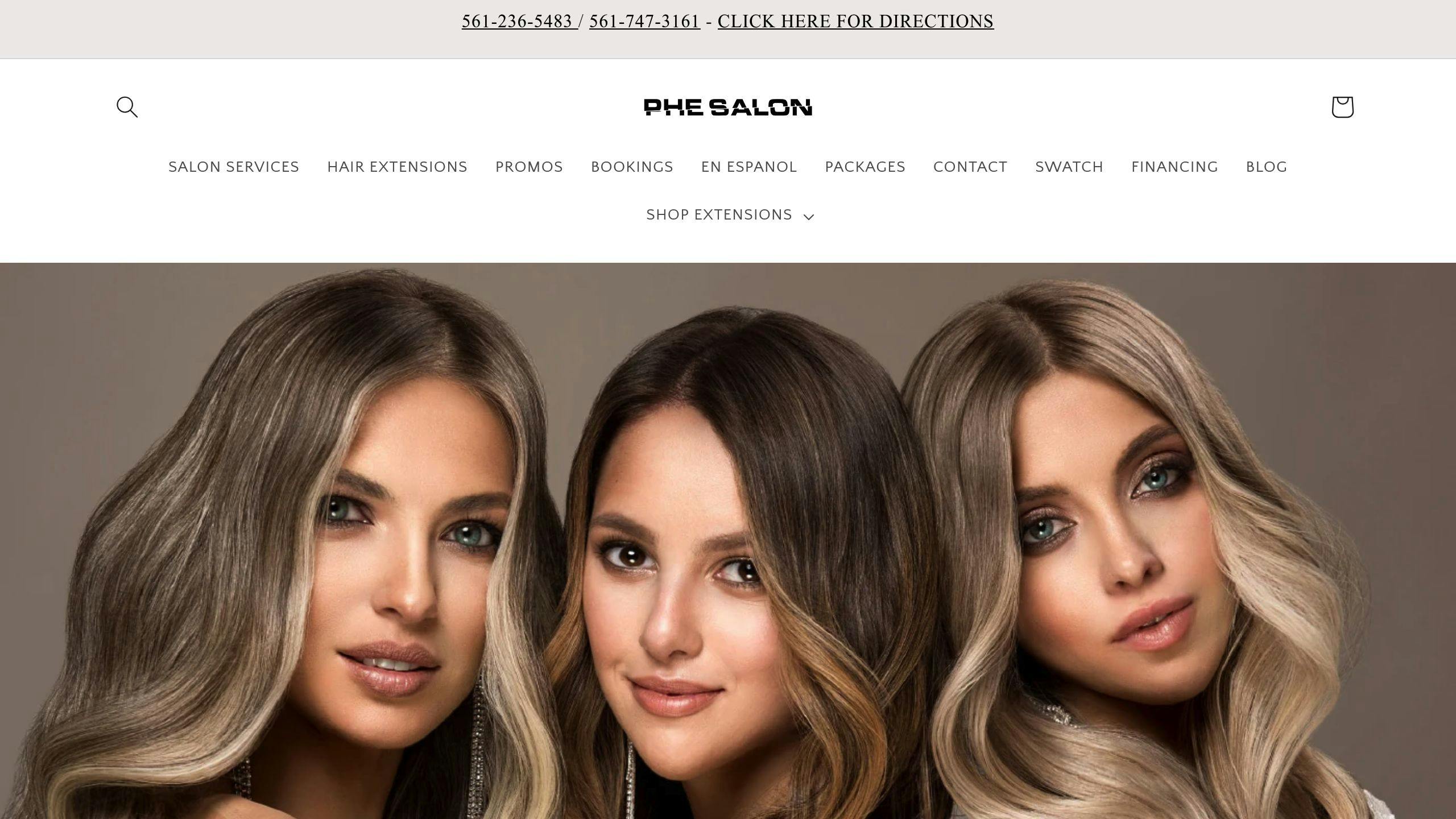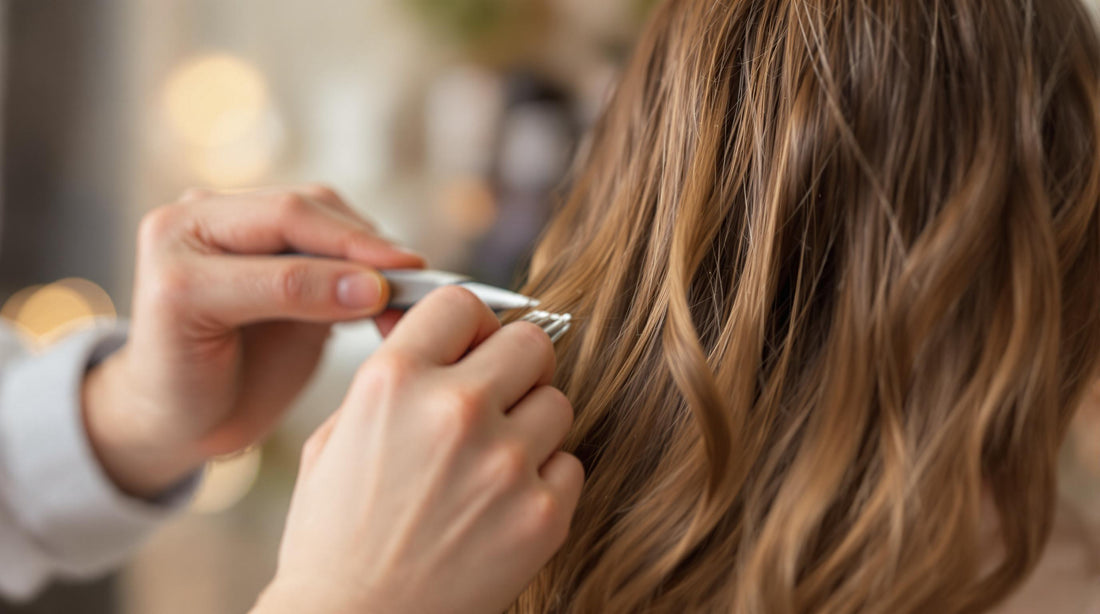Removing hair extensions at home can damage your natural hair. A professional stylist ensures safe removal, tailored to your extension type, and protects your hair's health. Here's what you can expect:
- Preparation: Use conditioner or oils a few days before to soften bonds and avoid heavy styling products.
- Removal Techniques: Professionals use specific tools like pliers, bond removal gels, or heat tools based on your extension type (micro rings, keratin bonds, pre-bonded, etc.).
- Aftercare: Clean your hair with clarifying shampoo, detangle gently, and use deep conditioning treatments to restore moisture and strength.
Why it matters: Improper removal can lead to breakage, tangling, or matting. Choose a salon with skilled stylists and personalized care plans to keep your natural hair healthy.
Getting Ready for Hair Extension Removal
Identifying Your Extension Type
Each type of hair extension requires specific tools and techniques for removal. If you're unsure about the kind you have, it's best to consult a professional stylist. They can correctly identify your extensions and help prevent damage during the removal process.
Scheduling a Consultation with a Specialist
A professional consultation is key to assessing both your extensions and your natural hair. Specialists can determine the most effective removal method while addressing any potential challenges. For example, at PHE Salon in Jupiter, Florida, experts offer personalized evaluations to create damage-free removal plans tailored to your needs.
During your consultation, share details about your hair care routine and any issues you've had with your extensions. This information helps in crafting the best approach for a smooth removal process.
Preparing Your Hair for Removal
Getting your hair ready in advance can make the removal process much easier. Here’s a simple timeline to follow:
| Timeframe | Preparation Steps | Purpose |
|---|---|---|
| 3-4 days before | Use conditioner or olive/coconut oil on bonds | Softens keratin bonds, making them easier to remove |
| 2 days before | Skip heavy styling products | Avoids product buildup that could complicate removal |
| 1 day before | Gently detangle your hair | Reduces removal time and minimizes stress on your hair |
"Regular maintenance and inspections can help prevent issues like excessive shedding, tangling, or matting, which are signs that your extensions need to be removed" [2].
How to Safely Remove Hair Extensions
How Professionals Remove Hair Extensions
Removing hair extensions professionally involves specific tools and techniques to protect your natural hair. Each extension type requires a tailored approach, making professional expertise essential.
Techniques for Different Extension Types
When prepared correctly, professional removal becomes a safer and smoother process. Here's how different extension types are removed:
| Extension Type | Tools Used | Removal Technique |
|---|---|---|
| Micro Ring | Micro ring pliers | Open the rings and slide out the wefts |
| Keratin Bonds | Bond removal gel, blunt nose pliers | Break down the bonds using gel |
| Pre-Bonded | Heat tools, ultrasonic devices | Soften the bonds for easy detachment |
Removing pre-bonded extensions can take 60-90 minutes, depending on the bond's condition. Timing is critical - too much heat can harm your natural hair, while too little won't release the bonds effectively [1].
For keratin extensions, professionals apply a bond removal gel to dissolve the adhesive, allowing them to remove the extensions gently without pulling or breaking your hair [3].
Why Professional Removal Matters
Getting your extensions removed by a professional reduces the risk of breakage or matting. Stylists use techniques and tools designed for your specific hair type and bond condition, such as bond removal gels or ultrasonic devices, to ensure safe removal.
"Regular professional removal and maintenance can significantly reduce the risk of damage and ensure the longevity of the hair extensions" [1].
Certified stylists also use products tailored to each bonding method [3]. They consider factors like hair texture, bond condition, and past treatments to ensure the process keeps your natural hair healthy and intact.
sbb-itb-4220d4e
Caring for Your Hair After Extensions Are Removed
Once your extensions are professionally removed, taking care of your hair is essential to keep it healthy and strong. This is a great time to focus on restoring your hair's natural condition.
Cleaning and Removing Residue
Start by thoroughly cleaning your hair to get rid of any leftover adhesive or product buildup. A gentle clarifying shampoo works well for this, as it removes residue without stripping away your hair's natural oils. Pay special attention to the areas where the extensions were bonded, as these spots often hold onto adhesive [2].
| Hair Care Step | Frequency | Purpose |
|---|---|---|
| Clarifying Wash | First 2-3 washes | Eliminate adhesive residue |
Once the residue is gone, you can move on to detangling and addressing any damage.
Detangling and Trimming Hair
Use a hair extension brush or a fine-tail comb to carefully detangle your hair. Start at the tips and work your way up to the roots to avoid unnecessary stress on your strands [4].
It’s also a good idea to visit a stylist for a trim. Removing split ends helps prevent further damage and promotes healthier growth [2].
Using Deep Conditioning Treatments
Deep conditioning treatments are a must during this recovery phase. These treatments help replenish moisture, strengthen your hair, and keep your scalp healthy. Look for products that are rich in protein and hydration, and consider pre-shampoo treatments with natural oils to add softness and shine [2].
For best results, apply deep conditioning treatments once or twice a week to:
- Rehydrate your hair
- Repair any damage caused by the extensions
- Support a healthy scalp
Give your hair a few weeks to recover before thinking about getting new extensions. Use this time to focus on regular conditioning and strengthening treatments, which will leave your hair in better shape for future styling or extension applications [1].
Finding the Right Salon for Extension Removal
Choosing the right salon for hair extension removal is key to keeping your hair healthy and ensuring a smooth return to your natural look. Professional skills and the right tools can make all the difference in this process.
Why PHE Salon in Jupiter, Florida Stands Out

PHE Salon brings together certified professionals, cutting-edge tools, and a personalized touch to provide safe and effective extension removal. They use specialized tools like bond removal gels and ultrasonic devices, paired with thorough post-removal hair care services. This expertise is especially helpful in tricky situations, such as dealing with extensions that were poorly applied or maintained.
| Service Feature | What It Means for You |
|---|---|
| Advanced Removal Tools | Quick and safe extension removal |
| Post-Removal Services | Full support for hair care |
| Handling Tough Cases | Skilled solutions for complex issues |
| Restoration Treatments | Focused care for hair recovery |
Beyond their technical know-how, PHE Salon ensures each client gets a personalized experience tailored to their specific hair needs.
Customized Care for Every Client
PHE Salon adjusts their methods to match each client's hair type and the type of extensions being removed. Their approach blends precise removal techniques with customized aftercare plans, emphasizing both safety and hair restoration.
When selecting a salon for extension removal, go for one that prioritizes both technical skill and hair recovery. This ensures not only a safe removal process but also proper care for your natural hair afterward.
Conclusion
Getting your hair extensions professionally removed is key to keeping your natural hair healthy. The process starts with assessing your extension type and consulting a trained specialist who can evaluate your needs. Using the right tools and techniques is critical for safe removal.
Experienced technicians know how to remove extensions without harming your hair. This is especially important if your extensions were damaged or not applied correctly. After the removal, proper care is essential to help your natural hair recover.
A good aftercare routine helps bring back your hair’s strength and health. Look for salons with experts who focus on maintaining hair health and can guide you through the recovery process.
With the right mix of skilled removal, proper tools, and customized aftercare, you can transition back to your natural hair while keeping it strong and healthy.
Think of professional hair extension removal as an investment in your hair’s future. Working with specialists who understand different extension types and removal methods helps avoid damage and ensures your hair stays in great condition. By choosing professional removal and focusing on aftercare, you’re setting your hair up for long-term health and styling options.

